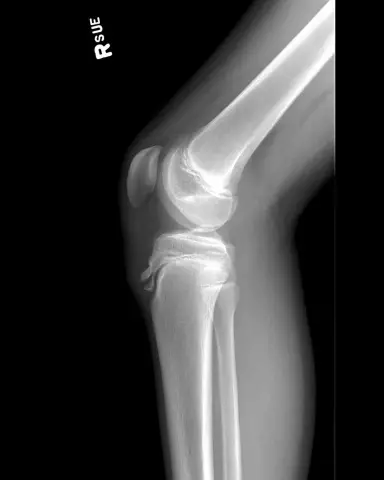- Author Rachel Wainwright [email protected].
- Public 2023-12-15 07:39.
- Last modified 2025-11-02 20:14.
Ureaplasmosis
Brief description of the disease

Ureaplasmosis in men and women is one of the most common infections in the category of sexually transmitted diseases. Despite the fact that the causative agents of ureaplasmosis have been identified for a long time and have been well studied, many experts still doubt whether ureaplasmosis can be considered a separate disease, or whether it is a consequence of any other processes occurring in the human body. Such doubts are based on recent studies, during which it was found that the causative agents of ureaplasmosis are present in the vagina of 60% of healthy women. Moreover, they are found in 30% of newborn girls. Cases of the appearance of ureaplasma in healthy men are recorded less often, but this happens regularly and can serve as a basis for well-founded conclusions. However, they have already been made. Several years ago, ureaplasmosis in men and women was defined as a conditionally pathogenic infection, and at present the initial hostility of its pathogens towards humans is being questioned.
Causative agent of the disease
Ureaplasmosis in women and men is triggered by the activity of ureaplasmas, which are similar to large viruses, since they have neither the cell membrane nor the DNA lost by bacteria during natural evolution. The very name of the infection "ureaplasmosis" is explained by the fact that ureaplasmas cannot exist without urea, which they destroy during their natural life cycle. The transmission of the causative agents of ureaplasmosis is carried out mainly during intercourse. The household route of infection is rarely recorded, and mostly children become infected, which is due to the imperfection of their immune system. Intrauterine infection is also possible, when the disease is transmitted to the fetus while still in the womb. I would like to immediately note that ureaplasmosis, the symptoms of which are observed during pregnancy, can lead to very sad consequences,therefore, expectant mothers must be checked for the presence of ureaplasmas. You should not be afraid of positive test results. The main thing is that the disease is detected on time, and pathogens can be easily destroyed with the help of antibacterial drugs.
Ureaplasmosis symptoms
Symptoms of ureaplasmosis in men and women appear about a month after infection, but, as mentioned above, with a favorable course, it may not manifest itself in any way for several years. In this case, everything depends on the state of health of a person with ureaplazosis, or rather, his immune system. The main protective factor of the body is the vaginal microflora, the normal ratio of various microorganisms. If for some reason the delicate balance is disturbed, ureaplasmosis begins to develop, the treatment of which is aimed at reducing the number of ureaplasmas. However, the main difficulty in this case is associated not so much with treatment as with the diagnosis of the disease. Ureaplasmosis manifests itself with minor symptoms. Many patients do not pay any attention to them,and therefore very often ureaplasmosis is detected only during routine examinations or studies of analyzes taken for a completely different reason.
The most typical symptoms of ureaplasmosis include:
- clear vaginal discharge;
- burning sensation when urinating;
- pulling pains in the lower abdomen;
- profuse and prolonged menstruation;
- menstrual irregularities;
- bleeding (rarely seen);
- the appearance of white discharge on the glans penis.
There is an opinion that ureaplasmosis in women and men often leads to infertility. This is not entirely true. As we have already said, infectious agents are present even in the microflora of absolutely healthy people, therefore, the inability to become pregnant is primarily affected by the presence of an inflammatory process. Prolonged uncontrolled reproduction of ureaplasma causes reproductive disorders, which can really result in infertility.
Ureaplasmosis during pregnancy
During gestation, when the protective barriers of the body are significantly weakened, even a small amount of ureaplasma is enough to start the development of infection. They do not cause malformations in a child, but can cause miscarriages, early births, polyhydramnios and fetaplacental insufficiency, which affects the normal development of the fetus, its supply of oxygen and nutrients. For this reason, ureaplasmosis, the symptoms of which are much more pronounced during pregnancy, is one of the infections that require constant monitoring and timely treatment. If it was possible to identify the symptoms of ureaplasmosis in time, the expectant mother is prescribed safe drugs that reduce the number of ureaplasmas, carry and give birth to a healthy child.
Infection of the fetus from the mother during gestation is extremely rare, since the baby is reliably protected by the placenta. Nevertheless, the number of newborns with diagnosed ureaplasmosis is constantly growing, since during childbirth the protective barriers no longer work. Accordingly, it is necessary to treat ureaplasmosis during pregnancy before the onset of labor. Usually a course of antibiotic therapy is prescribed during the 2nd trimester.
Diagnosis of the disease
To make an accurate diagnosis, doctors use a combination of several methods:
- bacteriological - allows you to accurately determine the number of ureaplasmas, for which the taken samples of materials are placed in a nutrient medium. Also, this method is used to identify the sensitivity of pathogens to certain drugs;
- polydimensional chain reaction is an operational diagnostic method that allows you to accurately determine ureaplasmosis in women and men within 5 hours after taking tests. The only drawback of this type of study is that it does not provide information on the number of pathogens, and, therefore, is not a basis for choosing a particular drug;
- serological method - designed to detect antibodies to ureaplasma antigens. It is used to determine the causes of early childbirth, infertility, complications in the postpartum period.
Treatment of ureaplasmosis

If studies have revealed an increased number of pathogens in the body, ureaplasmosis in men and women requires treatment. A small amount of ureaplasma is not a basis for prescribing a course of treatment for ureaplasmosis. The exception is women planning a pregnancy or already carrying a child.
Since pathogens are easily adaptable to the action of various antibiotics, it can be very difficult to find an effective remedy. Only bacterial studies with the determination of the sensitivity of microorganisms to the active ingredients of drugs can help in this. Usually experts use tetracyclines (doxycycline, tetracycline) and macrolides (wilprafen, clarithromycin, azithromycin). Almost all antibiotics are strictly contraindicated during pregnancy. If the expectant mother is diagnosed with ureaplasmosis, treatment involves the appointment of safe macrolides (erythromycin, rovamycin) and immunomodulators. The latter help to strengthen the immune system, which is very important for the successful treatment of the infection.
YouTube video related to the article:
The information is generalized and provided for informational purposes only. At the first sign of illness, see your doctor. Self-medication is hazardous to health!






